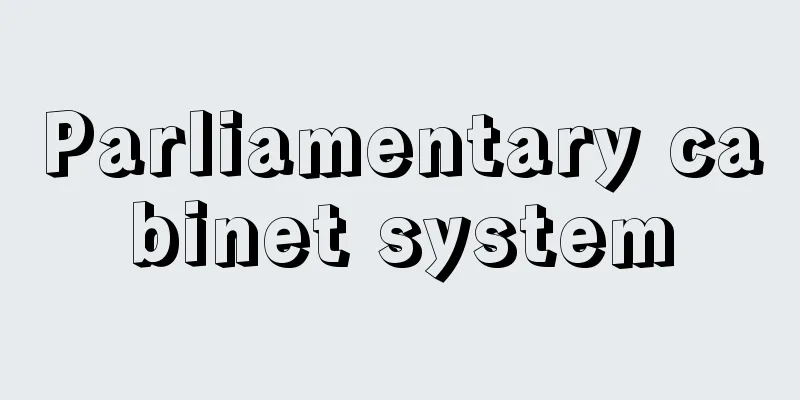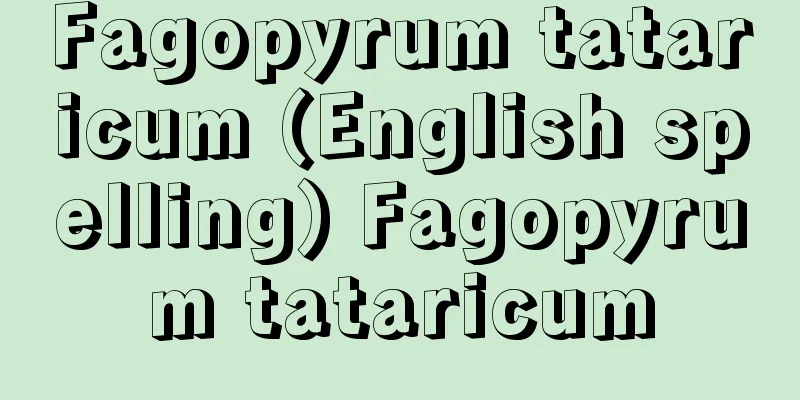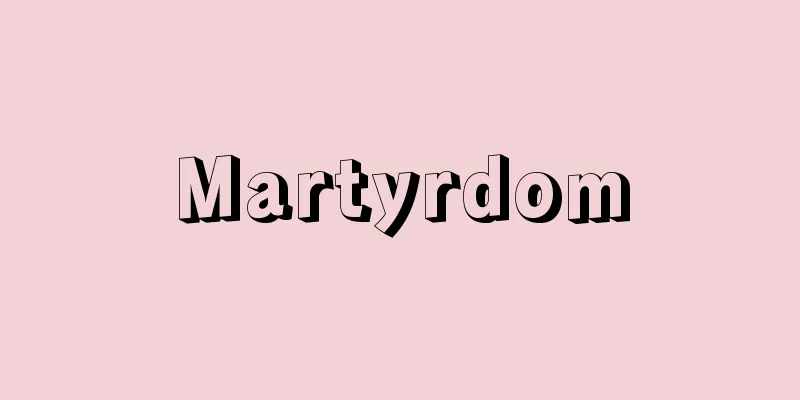Parliamentary cabinet system

|
A political system in which the term of office of the cabinet (government) is based on the confidence of parliament. It developed in the UK for a long time and is now used in many countries. [Hiroshi Tanaka] ContentsUnder a parliamentary cabinet system, a cabinet is formed by the majority party in parliament (a single-party cabinet) or an alliance of multiple parties with a majority (a coalition cabinet), so it is naturally a party cabinet (ministers of state are, in principle, members of parliament), and the cabinet runs the government while being jointly responsible to the parliament. Therefore, if a motion of no confidence in the cabinet is passed in the lower house or the House of Representatives (Japan), or a motion of confidence in the cabinet is rejected, the cabinet must either dissolve the parliament (the lower house or the House of Representatives) or resign en masse. [Hiroshi Tanaka] HistoryIn Britain, it took a long time for the political system and rules of the parliamentary cabinet system described above to become established as practice. In other words, the parliamentary cabinet system developed steadily at a slow pace from the time when Parliament gained its status as the most important political institution in British politics with the Glorious Revolution (1688) until the time when, after the first electoral reform (1832), the Whig and Tory parties changed their names to the Liberal Party and the Conservative Party, respectively, and parliamentary politics based on a two-party system was established in both name and reality. First, after the Glorious Revolution, William III appointed ministers from both Whigs and Tories, but in 1695, the Whigs, who were the majority party in the House of Commons, formed a single cabinet, and for the first time in British history, a party cabinet that reflected the will of the majority in the House of Commons appeared. Next, in 1742, when Walpole, the prime minister of the Whig cabinet, lost the confidence of Parliament, he resigned, even though he still had the support of the King. This marked the beginning of the practice of cabinets resigning due to a vote of no confidence. The practice of the so-called collective responsibility system, in which the entire cabinet resigns, began with the Rockingham cabinet in 1766. When he formed his cabinet (1765), he selected all of his ministers from the Whigs, and when they were voted no confidence, they all resigned. Then, the resignation of the Wellington cabinet (Tories) and the formation of the Grey cabinet (Whigs) in 1830 are noteworthy as heralding the full-scale beginning of party politics and the two-party system in Britain. [Hiroshi Tanaka] Parliamentary and presidential systemsThe American presidential system is contrasted with the parliamentary cabinet system. In a presidential system, the principle of separation of powers is strictly observed, and therefore the president, who is the head of the executive branch, is elected by a method different from that of the Diet members, and the various ministers who make up the executive branch are selected from those who do not hold seats in the Diet. Therefore, under this system, there is no dissolution system. There is a great deal of debate about the pros and cons of parliamentary cabinet systems and presidential systems, but the former has the advantage that the will of the people can be flexibly reflected in the political world by cleverly managing the dissolution system, while the latter has the advantage that the absence of a dissolution system allows political leaders to realize strong and stable politics. In any case, today, countries with parliamentary governments have adopted political forms that combine parliamentary cabinet systems and presidential systems in various ways according to the traditions and circumstances of each country. [Hiroshi Tanaka] Japan's Parliamentary Cabinet SystemThe Constitution of the Empire of Japan, which was modeled on the Prussian constitution, had no explicit provision regarding a parliamentary cabinet system, only stating that "the Ministers of State shall assist the Emperor and be responsible to him" (Article 55). This article meant that the Cabinet was not collectively responsible to the Diet, but that each Minister was individually responsible to the Emperor, so in Japan before World War II, healthy British-style party politics and a parliamentary cabinet system were difficult to establish, and aloof cabinets made up of bureaucrats and military factions held sway. However, from the Okuma-Itagaki Cabinet in 1898 (Meiji 31) to the Inukai Cabinet in 1931 (Showa 6), cabinets made up of political parties were formed, so it can be said that there were periods when the parliamentary cabinet system was in operation. However, the postwar Japanese Constitution, which aimed to establish democratic politics, codified the principle of a parliamentary cabinet system, stating that "executive power shall be vested in the Cabinet" (Article 65) and "The Cabinet shall be collectively responsible to the Diet for the exercise of executive power" (Article 66, paragraph 3). The Constitution also stipulated the conditions for the establishment of a parliamentary cabinet system, such as "dissolution and resignation" (Article 69), "designation of the Prime Minister" (Article 67), and "appointment and dismissal of Ministers of State" (Article 68), and thus the foundation was created for the development of a parliamentary cabinet system and parliamentary politics through a party cabinet in Japan. [Hiroshi Tanaka] "Constitutional Summary" by Masatsugu Inada (1954, Yuhikaku) "Approach to Political Science" by Hiroshi Tanaka and Yoshu Anjo (1978, Gakuyo Shobo) "History of the British Parliament" by Eisho Nakamura (1977, Yuhikaku) [Reference] | |Source: Shogakukan Encyclopedia Nipponica About Encyclopedia Nipponica Information | Legend |
|
内閣(政府)の在職要件が議会の信任に基づく、という政治制度。イギリスで古くから発達し、今日では多数の国々がこの制度を採用している。 [田中 浩] 内容議院内閣制下の内閣は、議会内での多数党(単独内閣)あるいは多数を制する複数政党による連合(連立内閣)によって組織されるから、当然に政党内閣(国務大臣は原則として国会議員)であり、内閣は議会に対して連帯責任を負いながら政治を運営する。したがって、下院や衆議院(日本)において内閣不信任決議案が可決、または内閣信任決議案が否決された場合には、内閣は議会(下院や衆議院)を解散するか、総辞職するかしなければならない。 [田中 浩] 沿革イギリスにおいて、以上に述べたような議院内閣制という政治運用上の制度やルールが慣行として定着するまでには長期にわたる歳月を要した。すなわち、名誉革命(1688)によって議会がイギリス政治における最重要な政治機関としての地位を獲得し、さらに第一次選挙法改正(1832)後、ホイッグ、トーリー両党がそれぞれ自由党、保守党と改名し、ここに名実ともに二大政党制による議会政治が確立する時点まで、議院内閣制はゆっくりした足どりで着実に発達してきたものと考えられる。 まず、名誉革命後ウィリアム3世はホイッグ、トーリー両党員のなかから大臣を任命したが、1695年には下院の多数党であったホイッグ党が単独内閣を組織し、イギリス史上初めて下院の多数意志を反映した政党内閣が出現した。次に、1742年にホイッグ党内閣の首相ウォルポールは議会で信任を失うや、いまだ国王の支持があったにもかかわらず辞職した。これは、不信任決議によって内閣が辞職するという慣行の始まりを意味した。内閣が総辞職するいわゆる連帯責任制の慣行は1766年のロッキンガム内閣の事例に始まる。彼は内閣を組織した(1765)際に、すべての大臣をホイッグ党議員から選び、不信任されたときには全員辞職したのである。そして1830年のウェリントン内閣(トーリー党)の総辞職とグレー内閣(ホイッグ党)の成立は、イギリスにおける政党政治・二大政党制の本格的幕開きを告げるものとして注目されよう。 [田中 浩] 議院内閣制と大統領制議院内閣制と対置されるものにアメリカ型の大統領制がある。大統領制においては三権分立主義が厳格に守られ、したがって、行政府の長である大統領は国会議員とは別の方法で選挙され、行政府を構成する各長官(大臣)は議席をもたない者から選任される。したがって、この制度の下では解散制度もない。議院内閣制と大統領制の利害得失については議論の分かれるところだが、前者については、解散制度の運用の妙によって国民の意志を柔軟に政治の世界に反映できる、また後者については、解散制度がないことによって政治指導者は強力な安定した政治を実現できる、という長所がそれぞれ主張されている。いずれにせよ、今日、議会政治をとる国々では、各国の伝統・実情にあわせてそれに議院内閣制や大統領制をさまざまに組み合わせた政治形態がとられている。 [田中 浩] 日本の議院内閣制プロシア型憲法に範をとった大日本帝国憲法においては、議院内閣制に関する明文の規定はなく、「国務各大臣ハ天皇ヲ輔弼(ほひつ)シ其(そ)ノ責ニ任ス」(55条)とだけあった。この条文は、内閣が議会に対して連帯責任を負わず天皇に対して各大臣がそれぞれに責任を負うことを意味したから、第二次世界大戦前の日本においてはイギリス流の健全な政党政治や議院内閣制はなかなか定着しえず、官僚・軍閥などによる超然内閣が勢いを振るった。しかし、1898年(明治31)の大隈(おおくま)・板垣内閣から、1931年(昭和6)の犬養(いぬかい)内閣までの時期には政党による内閣が組織されたこともあったから、運用の面では議院内閣制をとった時期も存在したということもできよう。 しかし、民主政治の確立を目ざした戦後の日本国憲法では、「行政権は、内閣に属する」(65条)、「内閣は、行政権の行使について、国会に対し連帯して責任を負ふ」(66条3項)として議院内閣制の原則を明文化した。そのほかこの憲法では、「解散と総辞職」(69条)、「内閣総理大臣の指名」(67条)、「国務大臣の任命及び罷免」(68条)など、議院内閣制が成立するための条件を規定し、ここに日本でも議院内閣制、政党内閣による議会政治が展開される基盤が生まれた。 [田中 浩] 『稲田正次著『憲法提要』(1954・有斐閣)』▽『田中浩・安世舟著『政治学への接近』(1978・学陽書房)』▽『中村英勝著『イギリス議会史』(1977・有斐閣)』 [参照項目] | |出典 小学館 日本大百科全書(ニッポニカ)日本大百科全書(ニッポニカ)について 情報 | 凡例 |
<<: Legislative proposal - Giinrippo
>>: Number of seats - Number of seats
Recommend
Quintana, MJ (English spelling) QuintanaMJ
…By the beginning of the 19th century, the bourge...
Saccostrea cucullata (English spelling)
…[Hiroshi Aramata]. … *Some of the terminology th...
Sons and Lovers
This is the third full-length novel by British au...
Shahn - Shahn (English spelling) Ben Shahn
A typical social painter born in the 20th century...
Metal engraving
A type of metal craft, it is one of the most well...
Kamikawachi [town] - Kamikawachi
A former town in Kawachi County in central Tochigi...
Tonans
…His name is a contraction of Dieu pater (meaning...
Volksmusik
...The term folk song (Volkslied or Volksgesang i...
Christmas carol
A general term for religious folk songs sung durin...
Thread spinning - Itomawashi
A special shamisen ensemble style. It was an enter...
First Dynasty of Ur - Urudaiichioucho
…It shows the rapid development of Ur during the ...
Acrylic resin - Acrylic resin
A typical type of plastic. It is the general name...
Precision machinery industry
This is an industry that produces instruments tha...
Archelon (English spelling)
A genus of reptiles in the order Cheloniidae that ...
Motacilla maderaspatensis (English spelling)
…[Hiroshi Hasegawa]. … *Some of the terminology t...









